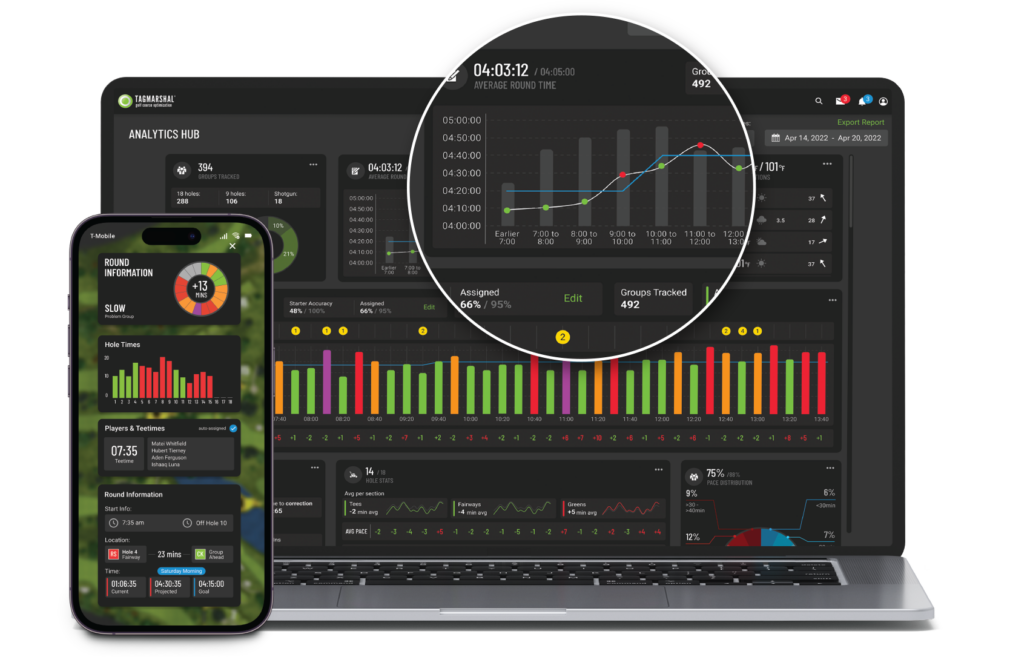Data attacks golf’s oldest and most persistent problem
By Steve Eubanks, Golf Business Magazine
The problem is as old as the game, and so are the debates on how to fix it. Ask any operator or any golfer to list their top-five gripes and “slow play” will fall somewhere near the top. For the player, it’s a maddening mixture of frustration and resignation, the kind of thing that drives many out of the game or at least away from more rounds than they might otherwise play. But for the operator, it’s a financial disaster. Footfalls on the first tee are the revenue engine of every club – public, private, resort or hybrid. Slow play limits rounds and reduces revenue. Full stop. Anything that can remedy that ailment is welcome news.

Enter Tagmarshal, a digital tracking product that does a good deal more than tell an operator where his slow groups are located. According to Bodo Sieber, the CEO of Tagmarshal, “The idea for the system came, as you might expect, during a very slow round of golf. My two partners played and were backed up with three groups waiting on the 14th hole. As often happens, they were saying, ‘Where is the marshal?’ When they got back, they came to me and said, ‘You’re a tech geek. Is there not something we can do to solve this?’” In the past, the answer has been, no. In a private club setting, the staff knows who the slow players are. There are rarely any mysteries among members. On the resort and public front, a marshal can only do so much. The guy shooting 140 paid the same fees as the single-digit handicap behind him. And when the tee sheet is full, letting a group or two play through doesn’t do much to solve the problem.
Clubs have tried building “time pars” into their GPS systems so messages flash when you’re behind. Unfortunately, golfers either ignore those messages or find them infuriating. The most hostile interactions on any given day occur when the marshal rolls up and says, “You guys are out of position and need to pick it up.” “The standard GPS system that you have on your typical golf cart is of great frontend value to the golfer,” Sieber said. “You can see how far you are from the flagstick, get a video flyover of the hole or at least a graphic overview, and maybe order some food for the turn. But there aren’t really back-end business applications there.
“Of course, the commercial engine at a course is high-quality rounds. Maximizing quality and quantity adds value. Given a course’s high fixed-cost base, any additional capacity you create is bottom-line profit. It’s like adding three more rows of seats to an airliner and selling them. The fixed costs remain the same.”

With that in mind, Sieber, the tech geek, created a device-and-software interface that tracks every player on the course and also provides impressive backend data to the management team. For cart riders, the device looks like your standard GPS. For walkers, it looks like a small cell phone that’s clipped to the golf bag or given to a caddie. “With the data we can generate, we add so much more value than the initial vision of making golf faster. We really have built a powerful business engine that looks at everything from round-time-per-hole to tee-box-wait-times as well as breakdowns of flow over particular times of day or particular days of the week. This allows the course to optimize everything from staffing to pin placements to ensure that the flow of play is consistent, and the quality of the experience is really high.
“With this technology, many courses simply do away with marshals altogether because that relationship is always adversarial. Instead, one of the assistants or other shop personnel goes out as a ‘play ambassador’ or some other name, armed with the data. They know exactly where to go because they know exactly where the holdup is. And they arrive armed with data on how long a group has taken to play each shot on each hole. That person then helps the group catch up by being with them and subtly showing them ways to move. Not once has the staffer needed to say, ‘You’re slow.’ It’s just showing them data and helping them move along.”
A decade ago, players might have balked at having the creepy eye of Big Brother attached to their golf bag. But with GPS tracking in cell phones, cars, computers and appliances, and AirTags being attached to everything from keys to pet collars, people have become accustomed to a tracking world. “At first, we were finding that people asked what it was all about, especially if they’ve been given a device to put on their golf bags,” Sieber said. “But once it’s explained that this is to eliminate slow play, they all said, ‘Thank goodness.’ There is no resistance after that.”

As of this writing, the Tagmarshal system is on 500 courses in 14 countries, with some impressive clients on the list. Baltusrol and Erin Hills were early adopters. Whistling Straits, Kiawah, Bandon Dunes, Oakmont, Pinehurst, even the DP World Tour and the R&A use the system for certain data points. And while the system was not originally built as an agronomic tool, the value to superintendents and general managers is astronomical. “We have built a system that displays a heat map of where people go and where hey don’t go, so you can track that over time,” Sieber said. “So, a superintendent can look at that map and use it for three purposes: First, to save on routine maintenance. You know with data whether or not you have to irrigate and fertilize certain areas. Just changing a sprinkler head from 360 degrees to 180 degrees saves half the water, for example.
The second area is determining how much or what parts of the course can be turned back to natural areas. We have several cases where a course looked at the patterns and a golf course architect said, ‘We now have an opportunity to extend our cost savings way beyond what we originally thought was possible.’” That’s what Baltusrol did during its renovation. As Gil Hanse looked at the Lower Course, the club provided him with the heat-map data, which made it much easier for Hanse to return certain areas to nature. “There is also a function of traffic control,” Sieber said. “Obviously, there are areas where you are not supposed to go, especially with a cart. The superintendent can tell where to put signage or put fencing or how to change the course.

“That is so vital because course planners can now look at the data and say, ‘If we just took out this one bush or this one tree or converted this one area back to clay or natural grasses, we could speed up play on this hole by six minutes.’ Conversely, sometimes you might want to make a hole more difficult and a little slower to open up a bottleneck that naturally occurs ahead. We can show the impact that these incremental changes make over long periods of time.
“Pinehurst has looked at another variable: green speeds. Obviously, if your speeds are tour grade, the weekend golfer is going to struggle, and pace-of-play will deteriorate. Operators have to find a balance. Guests want a major-championshipcaliber experience, but they also want to play in a reasonable time. Pinehurst has used the system to determine at what green speed play is optimized. “It’s actually about 25% slower than what the USGA recommends as a standard green speed, because of the course design and the number of rounds that they play.” A superintendent can also track his equipment to know exactly how long it takes to mow or maintain each area. And he can interface with the golf shop to see if there are any gaps in play so the crew can slip out and get some work done.
The art of business intelligence is to make data actionable and easy to digest,” Sieber said. “We realize that the majority of our market is not Baltusrol or Pinehurst. It’s Average Joe golf courses with $2.5 to $3 million in revenue. Those operators don’t have time to dig into the data like a major championship venue, so we have a level of the system that is appropriate for them. “But the nice thing about our system is that it becomes essential. Just as we have all become dependent on Map apps on our phones, our system can be understood at a glance by an 8-year-old. You don’t have to know all the calculations to get a great deal of usage out of it.
“Our clients look at our system 30 to 40 times a day because it becomes intuitive. Obviously, there are business analytics that can be used, but that is not for everyone. But everyone can use certain aspects of the system to incrementally improve the operations and track outcomes.”
ABOUT TAGMARSHAL
Tagmarshal, the market leader in on-course optimization technology, provides courses with full, real-time operational oversight and reporting, giving golf operators the tools to manage pace and flow of play effectively, resulting in enhanced player experiences, increased efficiency through automation, and additional revenue generation.
Tagmarshal’s technology has collected over 10 billion data points from more than 75 million rounds of golf and has relationships with in excess of 700 partners, including Hazeltine, Whistling Straits, Baltusrol, Fieldstone, Bandon Dunes, Serenoa and Erin Hills.
Tagmarshal partners with several golf management groups, private, daily fee, public and resort courses, including 40 of the Top 100 US courses, as well as many $40-$60 green fee courses, which are seeing excellent results using the system.
 WATCH DEMO
WATCH DEMO